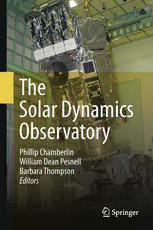Table Of ContentThe Solar Dynamics Observatory
Phillip Chamberlin (cid:2) William Dean Pesnell (cid:2)
Barbara Thompson
Editors
The Solar Dynamics
Observatory
Previously published in Solar Physics Volume 275,
Issues 1–2, 2012
Editors
PhillipChamberlin BarbaraThompson
NASAGoddardSpaceFlightCenter NASAGoddardSpaceFlightCenter
Greenbelt,MD Greenbelt,MD
USA USA
WilliamDeanPesnell
NASAGoddardSpaceFlightCenter
Greenbelt,MD
USA
ISBN978-1-4614-3672-0
SpringerNewYorkDordrechtHeidelbergLondon
LibraryofCongressControlNumber:2012933455
©SpringerScience+BusinessMediaB.V.2012
Allrightsreserved.Thisworkmaynotbetranslatedorcopiedinwholeorinpartwithoutthewrittenper-
missionofthepublisher(SpringerScience+BusinessMedia,LLC,233SpringStreet,NewYork,NY10013,
USA),exceptforbriefexcerptsinconnectionwithreviewsorscholarlyanalysis.Useinconnectionwithany
formofinformationstorageandretrieval,electronicadaptation,computersoftware,orbysimilarordissimilar
methodologynowknownorhereafterdevelopedisforbidden.
Theuseinthispublicationoftradenames,trademarks,servicemarks,andsimilarterms,eveniftheyare
notidentifiedassuch,isnottobetakenasanexpressionofopinionastowhetherornottheyaresubjectto
proprietaryrights.
Coverillustration:ThecoverimageshowstheSolarDynamicsObservatoryinthecleanroomatGoddard
SpaceFlightCenterundergoingfinaltestsandpreparationjustpriortoshippingtoFloridaforlaunch.Credit:
NASA/B.Lambert
Printedonacid-freepaper
SpringerispartofSpringerScience+BusinessMedia(www.springer.com)
Contents
Preface
R.R.Fisher 1
INTRODUCTION
TheSolarDynamicsObservatory(SDO)
(cid:3) (cid:3)
W.D.Pesnell B.J.Thompson P.C.Chamberlin 3
AIA
TheAtmosphericImagingAssembly(AIA)ontheSolarDynamicsObservatory(SDO)
(cid:3) (cid:3) (cid:3) (cid:3) (cid:3) (cid:3)
J.R.Lemen A.M.Title D.J.Akin P.F.Boerner C.Chou J.F.Drake
(cid:3) (cid:3) (cid:3) (cid:3) (cid:3)
D.W.Duncan C.G.Edwards F.M.Friedlaender G.F.Heyman N.E.Hurlburt
(cid:3) (cid:3) (cid:3) (cid:3) (cid:3) (cid:3)
N.L.Katz G.D.Kushner M.Levay R.W.Lindgren D.P.Mathur E.L.McFeaters
(cid:3) (cid:3) (cid:3) (cid:3) (cid:3) (cid:3)
S.Mitchell R.A.Rehse C.J.Schrijver L.A.Springer R.A.Stern T.D.Tarbell
(cid:3) (cid:3) (cid:3) (cid:3) (cid:3)
J.-P.Wuelser C.J.Wolfson C.Yanari J.A.Bookbinder P.N.Cheimets
(cid:3) (cid:3) (cid:3) (cid:3) (cid:3) (cid:3) (cid:3)
D.Caldwell E.E.Deluca R.Gates L.Golub S.Park W.A.Podgorski R.I.Bush
(cid:3) (cid:3) (cid:3) (cid:3) (cid:3) (cid:3) (cid:3)
P.H.Scherrer M.A.Gummin P.Smith G.Auker P.Jerram P.Pool R.Soufli
(cid:3) (cid:3) (cid:3) (cid:3)
D.L.Windt S.Beardsley M.Clapp J.Lang N.Waltham 17
InitialCalibrationoftheAtmosphericImagingAssembly(AIA)ontheSolarDynamics
Observatory(SDO)
(cid:3) (cid:3) (cid:3) (cid:3) (cid:3) (cid:3) (cid:3)
P.Boerner C.Edwards J.Lemen A.Rausch C.Schrijver R.Shine L.Shing
(cid:3) (cid:3) (cid:3) (cid:3) (cid:3) (cid:3) (cid:3)
R.Stern T.Tarbell A.Title C.J.Wolfson R.Soufli E.Spiller E.Gullikson
(cid:3) (cid:3) (cid:3) (cid:3) (cid:3)
D.McKenzie D.Windt L.Golub W.Podgorski P.Testa M.Weber 41
HeliophysicsEventKnowledgebasefortheSolarDynamicsObservatory(SDO)and
Beyond
(cid:3) (cid:3) (cid:3) (cid:3) (cid:3) (cid:3) (cid:3)
N.Hurlburt M.Cheung C.Schrijver L.Chang S.Freeland S.Green C.Heck
(cid:3) (cid:3) (cid:3) (cid:3) (cid:3) (cid:3) (cid:3)
A.Jaffey A.Kobashi D.Schiff J.Serafin R.Seguin G.Slater A.Somani
R.Timmons 67
ComputerVisionfortheSolarDynamicsObservatory(SDO)
(cid:3) (cid:3) (cid:3) (cid:3) (cid:3) (cid:3)
P.C.H.Martens G.D.R.Attrill A.R.Davey A.Engell S.Farid P.C.Grigis
(cid:3) (cid:3) (cid:3) (cid:3) (cid:3) (cid:3) (cid:3)
J.Kasper K.Korreck S.H.Saar A.Savcheva Y.Su P.Testa M.Wills-Davey
(cid:3) (cid:3) (cid:3) (cid:3) (cid:3)
P.N.Bernasconi N.-E.Raouafi V.A.Delouille J.F.Hochedez J.W.Cirtain
(cid:3) (cid:3) (cid:3) (cid:3) (cid:3)
C.E.DeForest R.A.Angryk I.DeMoortel T.Wiegelmann M.K.Georgoulis
(cid:3)
R.T.J.McAteer R.P.Timmons 79
EVE
ExtremeUltravioletVariabilityExperiment(EVE)ontheSolarDynamicsObservatory
(SDO):OverviewofScienceObjectives,InstrumentDesign,DataProducts,and
ModelDevelopments
(cid:3) (cid:3) (cid:3) (cid:3) (cid:3) (cid:3)
T.N.Woods F.G.Eparvier R.Hock A.R.Jones D.Woodraska D.Judge
(cid:3) (cid:3) (cid:3) (cid:3) (cid:3) (cid:3)
L.Didkovsky J.Lean J.Mariska H.Warren D.McMullin P.Chamberlin
(cid:3) (cid:3) (cid:3) (cid:3) (cid:3)
G.Berthiaume S.Bailey T.Fuller-Rowell J.Sojka W.K.Tobiska R.Viereck 115
ExtremeUltravioletVariabilityExperiment(EVE)MultipleEUVGrating
Spectrographs(MEGS):RadiometricCalibrationsandResults
(cid:3) (cid:3) (cid:3) (cid:3) (cid:3)
R.A.Hock P.C.Chamberlin T.N.Woods D.Crotser F.G.Eparvier
(cid:3)
D.L.Woodraska E.C.Woods 145
EUVSpectroPhotometer(ESP)inExtremeUltravioletVariabilityExperiment(EVE):
AlgorithmsandCalibrations
(cid:3) (cid:3) (cid:3) (cid:3)
L.Didkovsky D.Judge S.Wieman T.Woods A.Jones 179
HMI
TheHelioseismicandMagneticImager(HMI)InvestigationfortheSolarDynamics
Observatory(SDO)
(cid:3) (cid:3) (cid:3) (cid:3) (cid:3) (cid:3)
P.H.Scherrer J.Schou R.I.Bush A.G.Kosovichev R.S.Bogart J.T.Hoeksema
(cid:3) (cid:3) (cid:3) (cid:3) (cid:3) (cid:3)
Y.Liu T.L.DuvallJr. J.Zhao A.M.Title C.J.Schrijver T.D.Tarbell
S.Tomczyk 207
DesignandGroundCalibrationoftheHelioseismicandMagneticImager(HMI)
InstrumentontheSolarDynamicsObservatory(SDO)
(cid:3) (cid:3) (cid:3) (cid:3) (cid:3) (cid:3)
J.Schou P.H.Scherrer R.I.Bush R.Wachter S.Couvidat M.C.Rabello-Soares
(cid:3) (cid:3) (cid:3) (cid:3) (cid:3) (cid:3)
R.S.Bogart J.T.Hoeksema Y.Liu T.L.DuvallJr. D.J.Akin B.A.Allard
(cid:3) (cid:3) (cid:3) (cid:3) (cid:3) (cid:3)
J.W.Miles R.Rairden R.A.Shine T.D.Tarbell A.M.Title C.J.Wolfson
(cid:3) (cid:3)
D.F.Elmore A.A.Norton S.Tomczyk 229
ImageQualityoftheHelioseismicandMagneticImager(HMI)OnboardtheSolar
DynamicsObservatory(SDO)
(cid:3) (cid:3) (cid:3) (cid:3) (cid:3)
R.Wachter J.Schou M.C.Rabello-Soares J.W.Miles T.L.DuvallJr.
R.I.Bush 261
WavelengthDependenceoftheHelioseismicandMagneticImager(HMI)Instrument
onboardtheSolarDynamicsObservatory(SDO)
(cid:3) (cid:3) (cid:3) (cid:3) (cid:3) (cid:3)
S.Couvidat J.Schou R.A.Shine R.I.Bush J.W.Miles P.H.Scherrer
R.L.Rairden 285
PolarizationCalibrationoftheHelioseismicandMagneticImager(HMI)onboardthe
SolarDynamicsObservatory(SDO)
(cid:3) (cid:3) (cid:3) (cid:3) (cid:3)
J.Schou J.M.Borrero A.A.Norton S.Tomczyk D.Elmore G.L.Card 327
ImplementationandComparisonofAcousticTravel-TimeMeasurementProcedures
fortheSolarDynamicsObservatory/HelioseismicandMagneticImager
Time–DistanceHelioseismologyPipeline
(cid:3) (cid:3) (cid:3) (cid:3) (cid:3) (cid:3)
S.Couvidat J.Zhao A.C.Birch A.G.Kosovichev T.L.DuvallJr. K.Parchevsky
P.H.Scherrer 357
Time–DistanceHelioseismologyData-AnalysisPipelineforHelioseismicandMagnetic
ImagerOnboardSolarDynamicsObservatory(SDO/HMI)andItsInitialResults
(cid:3) (cid:3) (cid:3) (cid:3) (cid:3) (cid:3)
J.Zhao S.Couvidat R.S.Bogart K.V.Parchevsky A.C.Birch T.L.DuvallJr.
(cid:3) (cid:3)
J.G.Beck A.G.Kosovichev P.H.Scherrer 375
E/PO
TheSolarDynamicsObservatory(SDO)EducationandOutreach(E/PO)Program:
ChangingPerceptionsOneProgramataTime
(cid:3) (cid:3) (cid:3) (cid:3) (cid:3) (cid:3) (cid:3)
E.Drobnes A.Littleton W.D.Pesnell K.Beck S.Buhr R.Durscher S.Hill
(cid:3) (cid:3) (cid:3) (cid:3) (cid:3)
M.McCaffrey D.E.McKenzie D.Myers D.Scherrer M.Wawro A.Wolt 391
SolarPhys(2012)275:1–2
DOI10.1007/s11207-011-9914-3
THE SOLAR DYNAMICS OBSERVATORY
Preface
R.R.Fisher
Received:17November2011/Accepted:17November2011/Publishedonline:6January2012
©SpringerScience+BusinessMediaB.V.2012
MyinitialexposuretoearlydatafromtheSolarDynamicsObservatory(SDO)tookplace
lateonemorningintheSpringof2010andeventuallyendedintheearlyevening.Asnight
fell,Ifoundmyselffeelingexcited,alittlerelieved,andhugelyimpressedbythescientific
andtechnicalcontributionsofthosewhodevelopedtheSDOsystems.Iwasalsoconfounded
bywhatIhadseen.
Thedataweresorich!Thetemporalandspatialcontentoftheimagerywasoverwhelm-
ing. It took until the next morning for me to realize that the new data were, in fact, rev-
olutionary. In half a day, my understanding of the dynamic Sun had been swept away by
theSDOsystems.Themission’squestfornewobservingcapabilitywaswildlysuccessful!
IcouldonlyspeculateontheSDO’sfutureimpactonscientificresearch.
InitsfirstyearSDOhasgivenusunprecedentedviewsoffilamenteruptions,measured
thetotalenergyemittedbyflares,andstartedwatchingforactiveregionsbeforetheyerupt
throughthesolarsurface.Eachisavitalpieceinourunderstandingofsolaractivityandof
howthatactivitycreatesspaceweather.Filamenteruptionsarethesourceofcoronalmass
ejections,whilesolarflaresincreasesatellitedraganddisruptcommunications.Prediction
ofsolaractivityisagoalofSDOandknowingwheretheywilleruptisamajorsteptoward
short-termprediction.
SDOisthefirstspace-basedmissionofNASA’sLivingWithaStarprogram.Itcarries
three instruments dedicated to improving our understanding of the production, evolution,
anddestructionofthesolarmagneticfield.TheSDOscienceinvestigationteamsarecom-
mitted to rapidly providing their data to scientists, space-weather organizations, and the
public.
SDOprovidesfull-diskimagesoftheSuninmanywavelengths,startinginthesoftX-ray
andmovingthoughtheUVintothevisible.Magnetic-fieldmapsandDoppler-velocitymaps
TheSolarDynamicsObservatory
GuestEditors:W.DeanPesnell,PhillipC.Chamberlin,andBarbaraJ.Thompson
(cid:2)
R.R.Fisher( )
NASA/GoddardSpaceFlightCenter,Greenbelt,MD,USA
e-mail:richard.r.fi[email protected]
1 Reprintedfromthejournal
R.R.Fisher
arenowobtainedatcadencesneverbeforeachieved.TheEUVspectralirradianceismea-
suredatanunprecedentedrateallowingtheestimationofthetotalenergyradiatedbyeven
small,C-classflares.ThisirradianceisalsousedtocalibratetheEUVimages,sothatthe
radiancefromcoronalloopscanbemeasuredandconvertedintotemperaturemaps.Byre-
vealingglobalchangesinthesolaratmosphereoverspatialscalesrangingfromtheresolu-
tionlimittofractionsofasolardiameter,SDOiswritinganewchapterinourunderstanding
oftheSunandofhowspaceweatheriscreatedbysolaractivity.
ThisvolumeontheSolarDynamicsObservatory(SDO)missioncontinuesatraditionof
SolarPhysicstodedicatetopicalissuestomajorspacesciencemissions.Iencourageyouto
readthearticles,useSDOdatainyourresearch,andsimplyenjoylookingattheSuninthe
splendorthatSDOisrevealing.
Reprintedfromthejournal 2
SolarPhys(2012)275:3–15
DOI10.1007/s11207-011-9841-3
THE SOLAR DYNAMICS OBSERVATORY
The Solar Dynamics Observatory (SDO)
W.DeanPesnell·B.J.Thompson·P.C.Chamberlin
Received:16June2011/Accepted:7August2011/Publishedonline:18October2011
©TheAuthor(s)2011.ThisarticleispublishedwithopenaccessatSpringerlink.com
Abstract TheSolarDynamicsObservatory(SDO)waslaunchedon11February2010at
15:23UTfromKennedySpaceCenteraboardanAtlasV401(AV-021)launchvehicle.Ase-
ries of apogee-motor firingslifted SDO from an initial geosynchronoustransfer orbit into
acirculargeosynchronousorbitinclinedby28°aboutthelongitudeoftheSDO-dedicated
groundstationinNewMexico.SDObeganreturningsciencedataon1May2010.SDOis
thefirstspace-weathermissioninNASA’sLivingWithaStar(LWS)Program.SDO’smain
goalistounderstand,drivingtowardapredictivecapability,thosesolarvariationsthatin-
fluencelifeonEarthandhumanity’stechnologicalsystems.TheSDOscienceinvestigations
will determine how the Sun’s magnetic field is generated and structured, how this stored
magneticenergyisreleasedintotheheliosphereandgeospaceasthesolarwind,energetic
particles,andvariationsinthesolarirradiance.InsightsgainedfromSDOinvestigationswill
also lead to an increased understanding of the role that solar variability plays in changes
in Earth’s atmospheric chemistry and climate. The SDO mission includes three scientific
investigations (the Atmospheric Imaging Assembly (AIA), Extreme Ultraviolet Variability
Experiment (EVE), and Helioseismic and Magnetic Imager (HMI)), a spacecraft bus, and
adedicatedgroundstationtohandlethetelemetry.TheGoddardSpaceFlightCenterbuilt
andwilloperatethespacecraftduringitsplannedfive-yearmissionlife;thisincludes:com-
mandingthespacecraft,receivingthesciencedata,andforwardingthatdatatothescience
teams.ThescienceinvestigationsteamsatStanfordUniversity,LockheedMartinSolarAs-
trophysicsLaboratory(LMSAL),andUniversityofColoradoLaboratoryforAtmospheric
and Space Physics (LASP) will process, analyze, distribute, and archive the science data.
WewilldescribethebuildingofSDOandthesciencethatitwillprovidetoNASA.
TheSolarDynamicsObservatory
GuestEditors:W.DeanPesnell,PhillipC.Chamberlin,andBarbaraJ.Thompson
(cid:2)
W.D.Pesnell( )·B.J.Thompson·P.C.Chamberlin
NASAGoddardSpaceFlightCenter,Greenbelt,MD,USA
e-mail:[email protected]
B.J.Thompson
e-mail:[email protected]
P.C.Chamberlin
e-mail:[email protected]
3 Reprintedfromthejournal
W.D.Pesnelletal.
Keywords SDO·Solarcycle·Helioseismology·Coronal·Spaceweather
1. Preface:LivingwithaStarandtheSolarDynamicsObservatory
ThegoalofNASA’sLivingWithaStar (LWS)Programistoprovidethescientificunder-
standing needed to address those aspects of heliophysics science that may affect life and
society,whereheliophysicsisthestudyoftheSunandhowitinfluencesanddriveschanges
inallobjectswithinitsreach.Theultimategoalistodeveloptheabilitytopredictconditions
atEarthandintheinterplanetarymediumduetotheSun’sever-changingoutput,asubject
calledspaceweather.
LWSisdesignedtogiveusabetterunderstandingofthecausesofspaceweather,whose
effectscandisablesatellites,causepower-gridfailures,anddisruptglobalpositioningsys-
tem and other communications signals. The LWS program includes coordinated strategic
missions, missions of opportunity, a targeted research and technology program, a space-
environment testbed flight opportunity, and partnerships with other agencies and nations.
Each LWSmissionisdesignedtoanswerspecificsciencequestionsneeded tounderstand
theinterconnectedsystemsthatimpactus.
RadiationBeltStormProbes(RBSP),thesecondLWSmission,willbelaunchedin2012
to study the acceleration to high energies of electrons in the Earth’s radiation belts. Bal-
loonArrayforRadiationBeltRelativisticElectronLosses(BARREL)isamultiple-balloon
investigation of the Earth’s radiation belts that will fly from Antarctic stations during the
southernSummersof2012and2013.Twosolarmissions,SolarProbePlusandSolarOr-
biter (ajointmissionwithESA),areplannedforlaunchlaterthisdecade.Theywillstudy
thecoronalheatingandsolar-windaccelerationproblemsfromplatformsflyingclosetothe
SunandoutoftheEcliptic.
LWSisapartoftheInternationalLivingWithaStar(ILWS)Program,anorganization
bringingtogetherresearchersandspace-weatheroperatorstofurtherdevelopourabilityto
understandandpredictspaceweather.
2. Introduction
TheSolarDynamicsObservatory(SDO)isdesignedtoprovidethedataandscientificun-
derstandingnecessarytopredictsolaractivity,fromanticipatingwhetherflaresandCMEs
will occur the next day to the level of solar activity in future solar cycles. Monitoring the
topologyofmagneticfieldsastheyareformedwithintheSunitselfthroughtheouteratmo-
sphere,orcorona,byhigh-resolutionimagesmayprovidetheprecursorsforpredictingflares
and CMEs. A key insight that SDO hopes to provide is the topological configuration that
isneededtodrivereconnectionandreorganizationinthesebuilt-upandstressedmagnetic
fields–theenergyreleaseandsourcethatdrivesthesolareruptiveevents.
Longertimescalesrequireaknowledgeofhowmagneticfieldistransported,amplified,
and destroyed insidethe Sun and ultimately ejected from the interior – the solar dynamo.
BetweentheselimitingtimescalesanothergoalofSDOistopredictwhereandwhenactive
regionswillemerge,howthosemagneticfieldseruptanddecay,andhowthehostofother
phenomenarelatedtothesolarmagneticfieldcomeandgo.
SolarCycle24startedinDecember2008andispredictedtorisetoabelow-averagepeak
in 2013.This affords an excellent laboratory for SDO.All previous space-based missions
withsignificantdurationsampledSolarCycles20–23,whichhadabove-averagelevelsof
Reprintedfromthejournal 4

